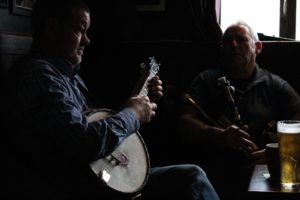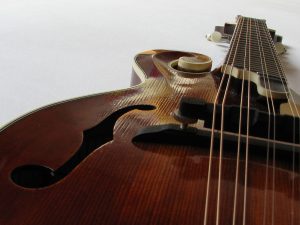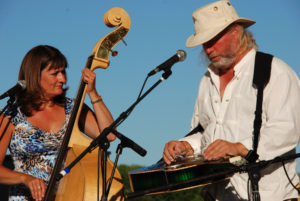Disclosure: Some of the links in this post are affiliate links. That means that if you click on a link and purchase an item, we may receive an affiliate commission at no additional cost to you. As an Amazon Associate I earn from qualifying purchases.
Trying to learn more about the bluegrass genre? Recently discovered bluegrass and want to learn more?
Whether you’re an avid listener of the bluegrass or you’re a musician interested in delving into the bluegrass sound, it’s important that you know which instruments make up this unique style.
While many things led to the unique sound, style, and culture of bluegrass music, much of it is due to the instruments that make up the genre. Many of the instruments are synonymous with the bluegrass sound. You’ll rarely see them outside of bluegrass music.
If you’re looking for a basic rundown of the most common bluegrass instruments, you’ve come to the right place. Below we’ll give you our list of the most essential bluegrass instruments.
Banjo

The banjo is probably the most recognizable bluegrass instrument and is what gives the genre much of its flavor. This unique-sounding instrument has 5 strings, and in bluegrass, it is usually played with fingerpicks, in a style that was popularized by Earl Scruggs, a pioneer of the genre.
Players tune the banjo to GDGBD, with the first G string being the highest string. This helps to give the banjo a rhythmic droning sound when played. While the banjo has made its way into many genres, it remains a staple of the bluegrass genre and doesn’t seem to be going anywhere anytime soon.
It’s also important to know that a 4-string banjo exists as well, but this type of banjo is more commonly heard in “old-time” music.
If you’re interested in learning the banjo, click here to see our list of the best banjos for beginners. Then, once you’re a pro, you may want to check out this list of the best professional banjos.
Mandolin

The mandolin is another distinctive instrument in the bluegrass genre. After all, it was the instrument of choice of The Father of Bluegrass Music, Bill Monroe.
The instrument has 8 strings, and the tuning is GDAE. This means that each string is doubled, is tuned the same, and is played with the same finger. While the instrument has 8 strings it feels more like you’re playing 4 strings instead.
The mandolin provides much of the rhythm of bluegrass music but is also great for playing solos and adding flourishes through the use of tremolos as well.
You may want to check out our list of the best mandolins for beginners if you want to learn more about this instrument. Additionally, our list of great mandolins under $1000 may also help you find the perfect instrument for you.
Be sure to check out our guide on the differences between the mandolin and banjo if you want to learn more about these unique bluegrass instruments.
Fiddle

The fiddle is another instrument that is a staple of bluegrass. While a fiddle is the exact same as a violin, the name changes based on how it is played. The fiddle has 4 strings and is tuned exactly the same as a mandolin at GDAE. The fiddle has been a common instrument in bluegrass but has also been common in precursors to the genre such as Irish and Scottish traditional music.
Interestingly, bluegrass instrumentals are often called “fiddle tunes”. When a band plays one of these tunes (which include favorites such as Blackberry Blossom, the Red-Haired Boy, and Salt Lake Creek), each instrument will take turns playing this lead part with its own individual variation.
FYI, here’s our list of the best fiddles for beginners.
Dobro

Made popular by Jerry Douglas, Rob Ickes, and Mike Auldridge, the dobro, or resonator guitar is another instrument that has made a lasting impact on the genre of bluegrass.
While arguably more fitting in progressive bluegrass settings, this instrument is considered to be one of the best of the genre. The dobro is characteristic of more modern styles of bluegrass and some traditionalists prefer to have their bands dobro-free.
Dobros help to put the “blues” in bluegrass. Few things beat the sound of the dobro and its smooth fills in slow ballads. Dobros often serve a similar place in the band as fiddles do, so it’s important that fiddle players and dobro players in a band are careful not to step on each other’s toes.
Interestingly, the resonator also has a place in Hawaiian music as well.
By the way, click here if you want to find the perfect dobro for you.
Upright Bass

While rock and roll may rely heavily on the electric bass, bluegrass music tends to feature the acoustic upright bass instead. The upright bass is essential for moving songs forward and giving them that driving rhythm.
Along with the mandolin, the combo serves as a great rhythm for bluegrass music in place of a drum set or other type of percussion. Bassists are often in high demand in the bluegrass genre since great upright bass players are sometimes hard to come by.
Guitar
The guitar is a necessary part of the bluegrass rhythm section and helps to fill in the gaps. This instrument has a major place in bluegrass just as it does in just about every other genre of music. Bluegrass guitar players are often known as “flatpickers” and while early on in bluegrass, guitar players only kept the rhythm, soloists are now very common.
Bluegrass guitar legends such as Tony Rice and Doc Watson and newer players such as Bryan Sutton, David Grier, and Tim Stafford rule the genre.
Other Instruments
While the instruments above are the most common ones in the bluegrass genre, bands of all kinds exist out there. Many bands mix up the basics and have other instruments in the band to provide for differentiation from the norm or just to offer highlights with special songs here and there.
In public bluegrass jams, attendees play many other instruments as well from time to time. Here are a few of the other instruments you may see in bluegrass music, either at jams or in bands.
- Diatonic Harmonica
- Chromatic Harmonica
- Mouth Harp/Jew’s Harp
- Accordion
- Autoharp
- Electric Guitar
- Piano
- Drums
- Banjo Hybrid Instruments
Some of the above instruments aren’t very common to see in bluegrass. However, many of these are becoming more common in bluegrass and its many sub-genres as time goes by.
Choosing the Best Bluegrass Instruments to Learn
There are a lot of interesting bluegrass instruments out there and learning one can be a lot of fun. You may want to consider learning one of the instruments above yourself if you want to start taking part in bluegrass jams that occur in town squares and bluegrass festivals across the country.
Want to learn more about bluegrass music? Be sure to check out our guide on bluegrass vs country if you want to understand the differences between these two music genres.

Hi, I’m Harrison! I created this website to help musicians navigate the ins and outs of their craft and to help them choose new instruments and gear to add to their collection. I have 15 years of experience as a guitarist and singer and have also played many other instruments throughout the years including the bass guitar, piano, banjo, mandolin, and harmonica.

